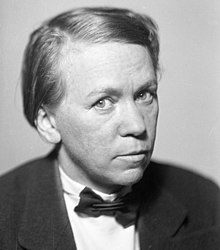Siri Derkert
| Siri Derkert | |
|---|---|

Siri Derkert in the 1940s
|
|
| Born |
Siri Karin Derkert August 30, 1888 , Sweden |
| Died | April 28, 1973 (aged 84) Lidingö, Sweden |
| Resting place | Lidingö churchyard 59°21′58.81″N 18°9′32.22″E / 59.3663361°N 18.1589500°E |
| Nationality | Swedish |
| Education | |
| Known for | Public art in Stockholm |
| Notable work | Ristningar i betong |
| Style | Expressionism |
| Spouse(s) |
|
| Website | siri |
Siri Karin Derkert (30 August 1888 – 28 April 1973) was a Swedish artist and sculptor. She was also a strong advocate for peace, feminism and environmental issues.
Derkert was born on 30 August 1888 in the parish of Adolf Fredrik Church in . She was one of seven children of merchant Carl Edward Johansson Derkert and Emma Charlotta Valborg, born Fogelin. She received her first artistic education at the Caleb Althin school of art in Stockholm, where she started in 1904. She went on to the Royal Institute of Art in 1911–13.
In 1913, Derkert moved to Paris where she studied at the Académie Colarossi and the Académie de la Grande Chaumière together with Swedish sculptors Ninnan Santesson and Lisa Bergstrand, until the start of World War I in the autumn of 1914. In February 1914, the three friends spent five weeks in Algiers where Derkert was introduced to more vibrant and bolder color schemes. During and after the war she spent some time in Italy, where her first child Carlo was born. Derkert was also a student at the Kvinnliga medborgarskolan vid Fogelstad (Fogelstad Citizen School for Women) where she arrived in September 1943. The stay proved inspirational for her later works. She made several sketches of the women in charge of the school, among them Honorine Hermelin and Ada Nilsson.
Derkert had three children: a son Carlo (1915–1994) with Finnish artist Valle Rosenberg and daughters Liv (1917–38) and Sara (born 1920) with Swedish illustrator Bertil Lybeck. Derkert was married to Lybeck in 1921–25, but they did not live together. Derkert died on 28 April 1973 in Lidingö, and is buried in the Lidingö churchyard.
Derkert is known as an artist with a strong personal and Expressionistic style. In her early works, particularly from her time in Paris, elements of both Cubism and Fauvism can be found. She made paintings of figures in grayscale, mostly using pastels as well as paintings of interiors and portraits of children. During the 1910s, she worked as a fashion illustrator. It was not until the 1940s, that she made her breakthrough in the art community. This also coincided with her new political engagement in the peace movement and feministic issues.
...
Wikipedia
